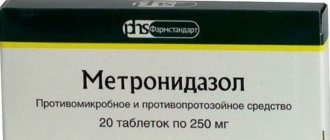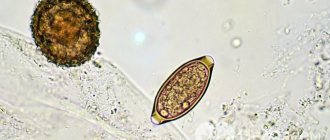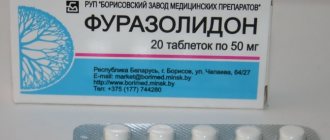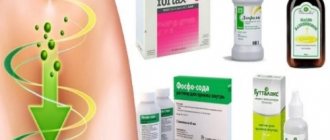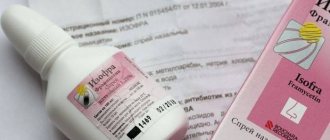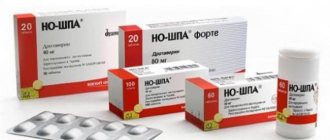Etiotropic therapy of giardiasis
The most commonly used drugs for Giardia are of three groups:
- The nitroimidazole group includes Tinidazole, Ornidazole and Metronidazole.
The effectiveness of Tinidazole is more than 75%, and Ornidazole is more than 90%. Basically, regimens with a single dose of the drug are prescribed, but there is a regimen for the treatment of giardiasis with Ornidazole in adults, in which it is necessary to take 1 tablet. Every 12 hours for 36 hours.
With a single dose of Ornidazole for adults and children whose body weight is above 35 kg, it is 1.5 g of the active substance per night. Children weighing less than 35 kg are prescribed the drug at the rate of 30-40 mg/kg body weight.
Tinidazole is not prescribed to children under 12 years of age. A single dose for adults is 2 g, for adolescents at the rate of 50-75 mg of active substance per 1 kg of body weight.
Both drugs can cause similar side effects in 15% of cases:
- general weakness, drowsiness, headaches;
- in rare cases, seizures may occur;
- distortion of taste perception, dyspeptic symptoms, increased liver transaminases;
- development of allergic reactions of varying degrees of manifestation;
- dysfunction of hematopoiesis in cases of long-term use.
Both Ornidazole and Tinidazole are strictly contraindicated during pregnancy; if it is necessary to take them during lactation, breastfeeding should be discontinued.
Widely known and often prescribed for many diseases, Metronidazole has recently been less and less prescribed as a medicine for Giardia, due to the emergence of metronidazole-resistant forms of the latter.
- The nitrofuran group is represented by Mikmiror (Nifuratel) and Furazolidone, which is practically no longer prescribed due to the high resistance of Giardia to it, as well as due to the frequent development of adverse reactions.
Today Mikmiror is the most effective drug for the treatment of giardiasis, since:
- its toxic effect on the liver is minimal, and side effects were observed in only 2% of patients;
- well excreted by the kidneys;
- also effective against salmonella, shigella and other intestinal infections, Helicobacter pylori and Candida fungi.
Although rare, Microror can cause:
- feeling of bitterness in the mouth, nausea;
- skin itching and rash.
Nifuratel is not recommended for use during pregnancy and breastfeeding, since it can penetrate both the placental barrier and into breast milk.
The treatment regimen for giardiasis with Microror is as follows:
- adult patients are prescribed the drug 2-3 times a day, 400 mg – 7 days;
- children are prescribed at the rate of 15 mg per 1 kg of body weight 2 times a day – 7 days.
Since Microror is the safest drug against Giardia, it can be prescribed even to infants older than 2 months.
- A representative of the benzimidazole group is the drug Albendazole (Nemozol, Aldazole, Gelmodol-VM, Sanoxal), well known to many parents, which is active not only against worms, but also against Giardia.
This universal anthelmintic, which has a wide spectrum of action on the larval and mature stages of various helminths, inhibits their absorption of glucose. It is prescribed for infection with pinworms, trichinella, roundworms, necator, hookworms, pork, bovine and dwarf tapeworms and other helminths.
It is produced both in tablet forms and in suspension, which makes it possible to prescribe this medication to young patients, but not earlier than 2 years of age and weighing more than 12 kg.
For giardiasis, Albendazole is prescribed 400 mg once a day after meals for 3-7 days. The average duration of the therapeutic course is 5 days. The duration of treatment is determined by the tolerability of the drug, the presence of concomitant diseases and the possibility of side effects.
Side effects from benzimidazoles may include the following:
- weakness, lethargy, general malaise, dizziness and headaches;
- arterial hypertension;
- nausea, vomiting, abdominal pain;
- dysfunction of the excretory system;
- increased levels of liver transaminases;
- disruption of hematopoietic processes;
- allergic reactions.
The use of Albendazole during pregnancy and lactation is strictly contraindicated.
What kind of parasites are these?
Giardia are not microbes or worms, they are among the simplest single-celled creatures that were discovered by the inventor of the microscope, Leeuwenhoek, almost 4 centuries ago.
It is believed that only children suffer from giardiasis, this is not entirely correct; adults get sick in the clinical form much less often, but they suffer the disease more severely.
You can become infected in the following cases:
- drinking untreated water or foods contaminated with cysts (fruits, vegetables);
- swimming in small ponds or sunbathing on the coastal sand;
- contact with an infected person or common objects - on the street, at home or in children's groups;
- communication with domestic or stray animals.
Ingestion of 10-15 cysts is sufficient for the development of the disease. In the small intestine of humans, they transform into a motile flagellated form, cover the entire mucous membrane of the duodenum and feed at the expense of the host, gradually poisoning him with the products of their vital activity.
Giardia infection occurs through the fecal-oral route. Protozoa enter the body in the form of cysts. The main habitat of Giardia is the small intestine. There they attach to the wall and become parasites.
Causes of Giardia
Giardia infection is possible in the following cases:
- with water containing cysts;
- when eating food containing Giardia;
- upon contact with a patient.
Komarovsky reported that for a child or adult to become infected with a 30% probability, it is enough to ingest 10 cysts. When 25 cysts enter the digestive tract, the disease develops in 100% of people.
Dr. Komarovsky said that the frequency of people suffering from giardiasis in the population may vary depending on compliance with sanitary and hygienic rules and regulations. Thus, he noted that in countries where it is customary to clean the streets, including from pet feces, drink high-quality drinking water, and wash hands for at least 25 seconds, the incidence of the disease decreases to 2%. And in the CIS countries, parasites can be found in 25-35% of the population.
Anxious parents, fearing infection, consider any ailments associated with abdominal pain, diarrhea or constipation to be symptoms of Giardia in children. It is widely believed that protozoan infection leads to long-term or recurring skin allergies in a child.
Situations arise when patients are given referrals for questionable methods for diagnosing Giardia. The study is carried out using alternative methods, then the parasite is “discovered” and drugs that do not have proven clinical effectiveness are prescribed.
So Giardia can be found in anyone. Suspicious citizens study information about their danger and try to “prescribe treatment” for children in order to avoid serious complications.
Giardia in a child
Scientists have not identified a connection between the presence of the parasite and decreased immunity. Describing the symptoms of Giardia in children, a famous pediatrician calls for relying on the criteria of the World Health Organization (WHO):
- the fact of long-term – from 10 days of diarrhea;
- no increase in body temperature;
- absence of other intestinal infections;
- detection of cysts in stool analysis.
The pediatrician noted that many children can be suspected of developing giardiasis, but fears are not grounds for making a diagnosis.
Treatment should be started immediately! Protect yourself and your loved ones!
Probiotics in the treatment of giardiasis
Since any treatment of parasitosis must be comprehensive, it is advisable to add probiotics, for example, Enterol, to the therapeutic course. The live fungi Saccharomyces boulardii contained in it, useful for restoring the intestinal microflora, also have some anti-giardiasis activity.
In addition to restoring intestinal microflora, Enterol is recommended for the treatment and prevention of diarrhea. The use of this drug in the treatment of giardiasis significantly increases the effect and activity of specific drugs, but it should not be prescribed with Microror, since nifuratel has antifungal activity, and therefore will inhibit the action of Enterol.
The drug is well tolerated and has virtually no contraindications. It is not advisable to prescribe it to children under 12 months, since the intestinal walls in their bodies are permeable to any fungi, and should not be prescribed to persons at risk of developing generalization of fungal infections, for example, patients with indwelling venous catheters.
Like most other probiotics, Enterol is taken according to the following regimen:
- 1 capsule or 1 sachet 1-2 times a day for adults and children over 3 years old for 7-10 days;
- 1 capsule, dissolved in cooled boiled water 2 times a day for 5 days for children from one year to 3 years.
In addition to Enterol, you can prescribe probiotics such as Bifidumbacterin, Lactobacterin, Linex, Acepol, Probifor.
The only drawback of probiotics is that their activity is quite weak, i.e. they can pass through the intestines in “transit”.
Characteristic manifestations
With the active proliferation of Giardia, first of all, the processes of parietal digestion and absorption are disrupted, and inflammatory-dystrophic changes in the small intestine develop.
This is what causes the appearance of characteristic symptoms:
- prolonged disturbances in the character of stool - frequent diarrhea with greenish stool and a strong unpleasant odor;
- nagging pain in the umbilical region;
- nausea with periodic vomiting (usually bile);
- weight loss;
- periodic low-grade fever, without discomfort;
- increased excitability of the child, teeth grinding at night;
- night attacks of suffocating cough;
- enlargement of peripheral lymph nodes;
- the appearance of an itchy rash;
- reduced immunity.
The listed symptoms can be single or manifest in a complex manner. It should be noted that they are not highly specific, so recognizing giardiasis is not so easy
But, in any case, parents will notice that the child has become less active and lethargic
Restoration of intestinal microflora after treatment
For more effective and independent restoration of damaged intestinal microflora, it is advisable to use prebiotics - preparations containing active substances that can catalyze the growth of necessary microorganisms in the intestinal lumen. For this purpose, LactusanYu Lactofiltrum, Prelax and other drugs are prescribed for a period of up to 14 days.
As a rule, a single dose of prebiotic syrups is 10 ml for adults and 5 ml for children. Capsules or pills are taken in the same way as syrup - 2 times a day, 3-5 capsules at a time, depending on the age and body weight of the patient.
Giardia in children symptoms
The incubation period is characterized by its short duration. Then the acute stage of the disease begins with frequent relapses. Differentiating a characteristic illness is as easy as shelling pears; a presumptive diagnosis of giardiasis is made after collecting anamnesis data and a detailed study of the clinical patient’s complaints. So, the signs of Giardia in children have the following varieties, most often prevailing in the complex:
- attacks of nausea, less often vomiting;
- dizziness, headache;
- pain in the upper abdomen;
- chronic constipation, diarrhea;
- belching after eating;
- bloating, flatulence;
- yellow stool with the consistency of porridge;
- sudden weight loss;
- decreased appetite;
- general weakness, increased fatigue;
- signs of dyspepsia, unpleasant rumbling;
- recurrent skin rash (atopic dermatitis);
- poor sleep, excessive irritability;
- feces with mucus admixtures;
- temperature jump above 38 degrees;
- teeth grinding at night;
- redness in the navel area.
To help etiotropic treatment
To increase the effectiveness of drug treatment, patients suffering from giardiasis are recommended to limit sweet, salty, starchy, spicy, fried foods, as well as strong, rich broths and fatty meats.
Instead, you should enrich your daily diet with foods rich in dietary fiber and vitamins, and also remember to drink plenty of fluids.
After completing the course of treatment, control parasitological examinations are carried out after 2, maximum 3 weeks. If Giardia is not detected during control, clinical remission is considered. But a complete cure is judged when Giardia is absent in the next 2-3 tests over a period of six months.
In case of reappearance of symptoms typical of giardiasis, an anti-relapse course of Mikmiror or Albendazole is prescribed without prior examination.
How to identify Giardia in a child
In the acute stage, giardiasis is usually expressed by obvious clinical signs, but the chronic stage can be completely asymptomatic.
Acute giardiasis develops when a huge number of cysts enter a child’s body at the same time, which begin to irritate the gastric mucosa. During this period, the child may experience the following symptoms:
- Loss or complete loss of appetite, feeling of nausea, sometimes vomiting;
- Bloating, rumbling in the tummy that occurs after eating;
- Extensive skin rashes resembling rubella;
- Increased body temperature (often up to 39 degrees);
- Stool disorders (constipation or diarrhea);
- Unpleasant sensations in the navel area, irregular nagging pain in the upper abdomen;
- Moodiness, irritability;
- General weakness;
- Feces have an uneven consistency, a yellowish color, and may contain mucus;
- Grinding of teeth;
- Discomfort and itching in the anal area.
At the acute stage, doctors usually rarely diagnose giardiasis, starting to treat the child for various other ailments, because similar symptoms are inherent in both digestive disorders and dysbiosis.
With giardiasis, the processes of absorption and assimilation of necessary substances are disrupted, as a result of which vitamin deficiency develops and there is a lag in the growth and general development of the child
While the child is being unsuccessfully treated by neurologists, dermatologists, allergists and other specialists, the disease enters the chronic stage. The symptoms of chronic giardiasis are not so pronounced, but under the influence of prolonged intoxication the functioning of various organs and systems of the body is disrupted, and the following clinical picture develops:
- Peeling and dry skin;
- Lack of appetite;
- Pale skin, dark circles under the eyes;
- Bad breath, coating on the tongue;
- Abdominal pain of an unstable nature, severe diarrhea;
- Emotional instability, mood swings;
- Increased sweating.
The listed signs of the presence of Giardia can occur in combination and separately, or not appear at all. Giardiasis can only be reliably diagnosed in a clinical setting, using the following studies:
Scatological examination allows you to detect Giardia in a child’s stool with a 70% probability. However, the analysis is not always reliable, because Parasites in feces can appear periodically. Therefore, to confirm the results, the analysis must be carried out over time - once a week for a month.
During scatological analysis, stool is examined for the presence of cysts; for greater efficiency and accuracy of this method, it is worth retaking the analysis again after a week
- Serological testing is a blood test for Giardia in children, which allows the most informative identification of parasites by identifying specific antibodies. The disadvantage of this method is that it detects parasites only within 3-4 weeks after infection, because Chronic giardiasis is difficult to diagnose using a blood test.
- Duodenal examination is a very informative, but very complex and painful diagnostic method, so it is rarely prescribed to children, and is completely contraindicated for children under 10 years of age.
Sometimes, to establish the presence of giardiasis, it is enough to conduct one of the listed studies, but if there are doubts about the diagnosis, it is better to carry out the examinations in combination.
If the diagnosis of giardiasis is confirmed, then treatment is started immediately, which may take a long time.
Side effects
Pyrantel is recognized as a safe treatment for giardiasis, but may cause undesirable symptoms. Since they are similar to the symptoms of giardiasis, they are practically not felt, but you can notice an increase in the following symptoms on the first day of therapy.
- vomit;
- nausea;
- pain in the stomach;
- elevated temperature;
- noises in the head;
- severe fatigue;
- sleep disorders.
Some side effects are caused by intoxication of the body by parasites, or rather by the toxins that they release after their death. These symptoms go away on their own after Giardia is removed from the body.
If you ignore the doctor’s recommendations, exceed the dosage, or self-medicate, side effects of the medication may occur. The most common reaction is allergies in the form of dermatitis, rashes, redness, etc.
Contraindications
A direct contraindication to the use of Pirantel is individual intolerance to the constituent components by the body. It manifests itself as an allergic rash on the skin, itching, increased unpleasant symptoms, and deterioration in general well-being. It is prohibited to take the drug in the future.
- severe liver disease;
- hypertension;
- myasthenia gravis;
- angina pectoris;
- tachycardia;
- age up to 2 years.
It is strictly forbidden to use Pirantel together with Piperazine, Levamisole for giardiasis in adults and children to avoid overdose. Combination treatment should be prescribed by a doctor.
Reception for the purpose of prevention
Pyrantel is ideal not only for the treatment of giardiasis, but also for its prevention. If there are pets in the house, or a child attends kindergarten or school, then the product will help prevent the body from becoming infected with parasites. You must first consult a specialist to avoid the development of side effects of the drug.
Giardiasis can easily be called a problem of unwashed hands. Many people are embarrassed to admit their illness, so they simply tolerate it and do not seek treatment. However, today there are many effective remedies to cope with Giardia, so you should not be afraid to talk about disturbing symptoms.
But you shouldn’t take Pirantel without consulting your doctor. After all, it is a qualified physician who is able to conduct all the necessary tests and prescribe adequate therapy, which will quickly relieve the patient of an unpleasant disease.
Analogues of the drug
Complete analogues of Pyrantel according to the active substance are:
- Helminthox;
- Nemocid;
- Kombantrin.
Analogs
Analogs with a similar mechanism of action:
The price of analogues jumps 10 rubles. up to 100 rub. You can purchase drugs in pharmacies and on websites on the Internet. The drugs are often dispensed without a prescription, but must be sold on the recommendation of a doctor.
Using medications for Giardia during pregnancy
Almost all drugs for the treatment of giardiasis are highly toxic. Therefore, most often they are not prescribed for the treatment of pregnant women and infants. In addition, many of the medicinal antiprotozoal drugs are prohibited for use during lactation. Some of them have strict age restrictions.
Thus, Trichopolum is not prescribed in the first trimester of pregnancy. In the future, the use of the drug is possible only after receiving medical advice. A drug such as Macmiror can be taken by a woman during pregnancy and lactation. It is often prescribed to treat giardiasis in children.
Does Pirantel help with Giardia?
To destroy helminth infestations in the body, the first step is to destroy them with a toxic drug. Then remove it from the body and restore the immune system. Whether this or that drug helps against Giardia depends on the individual characteristics of the body and the specific case of infection. An influential factor is the degree of reproduction of parasites in the host, the period of their stay in it, the general condition of the body and the tolerance of medicinal components to patients.
The pharmaceutical industry produces a very large number of drugs to eliminate invasion. Doctors say that it is necessary to fight helminths and it is important not to start this process. The incubation period for Giardia infection takes from one to three weeks, after which mild symptoms may appear. When there is a suspicion that parasites have settled in the body, you need to consult a doctor. Only a doctor knows whether such a well-known drug as Pirantel will help against Giardia. But ordinary people say that this is an old and proven medicine that is worth attention.
"Pyrantel" is prescribed and prescribed to both adults and children. Manufacturers say that it has gentle properties on the body and helps not only kill parasites, but also remove them from the body. But it is better to use it not at the preparatory stage, when destroying toxins in the body and preparing organs and systems, but during their further removal. The main active ingredient is imetazole, which is an antifungal and anthelmintic agent. Some types of parasites are resistant to this drug, so it may not be effective in treating the infestation.

